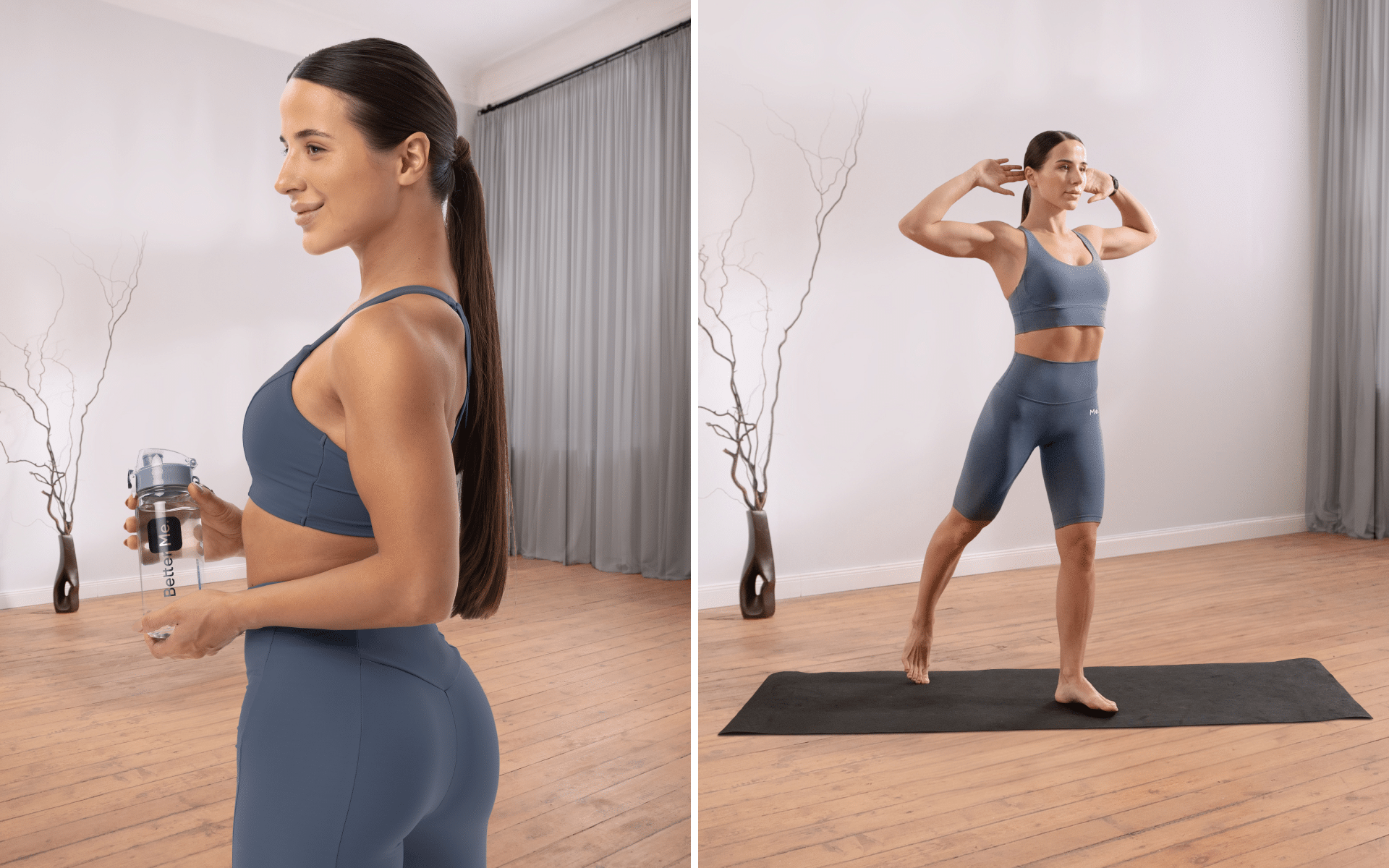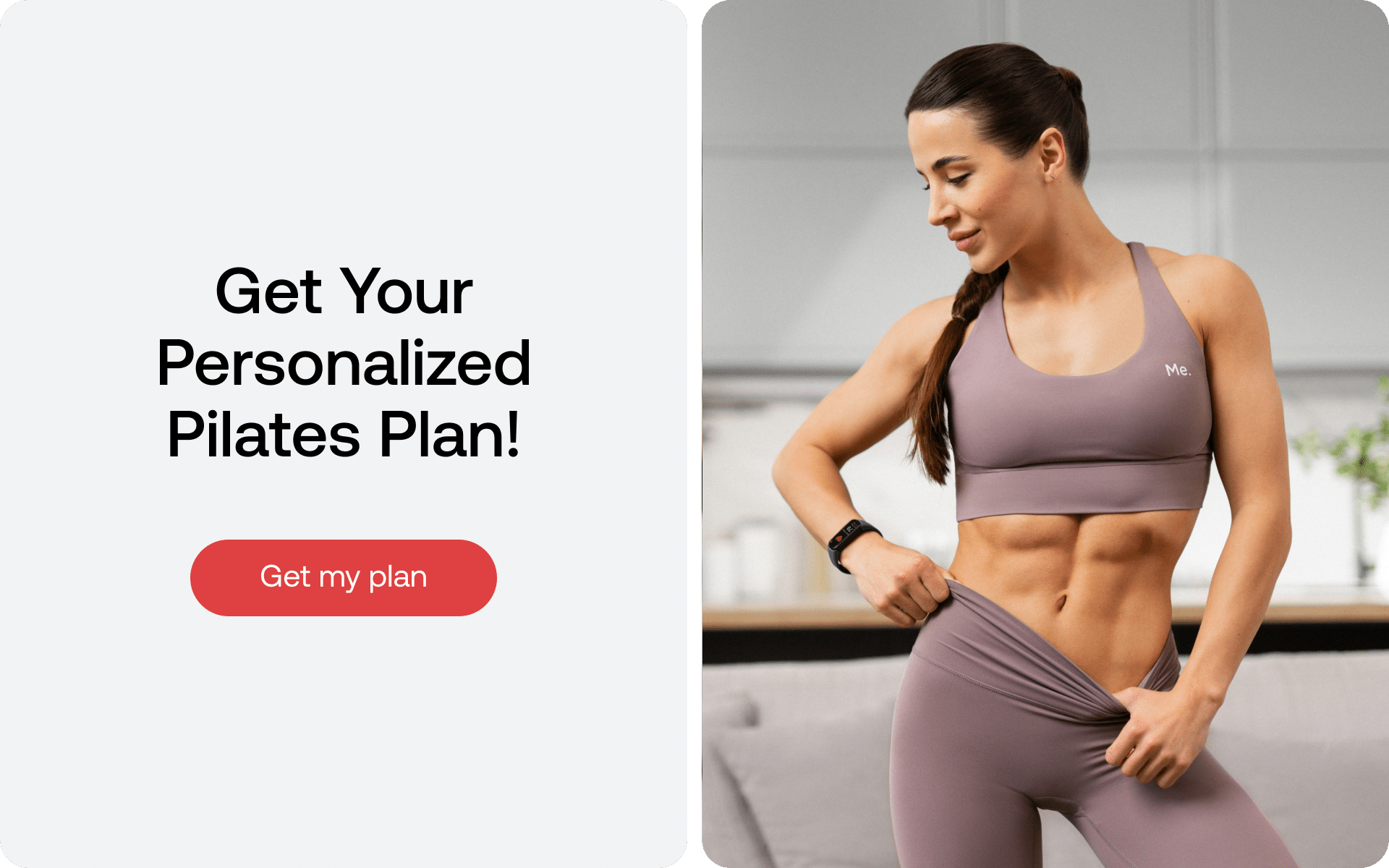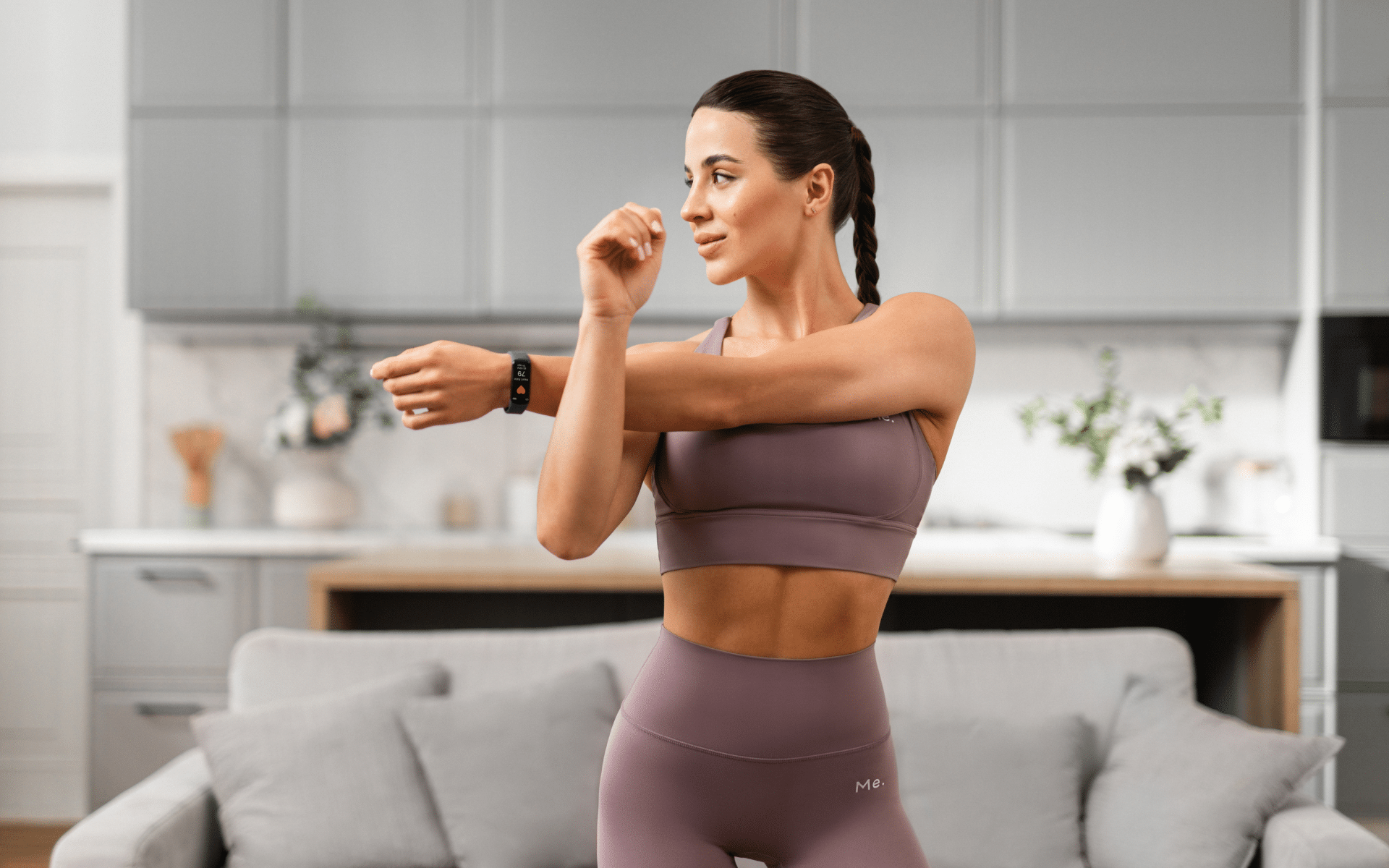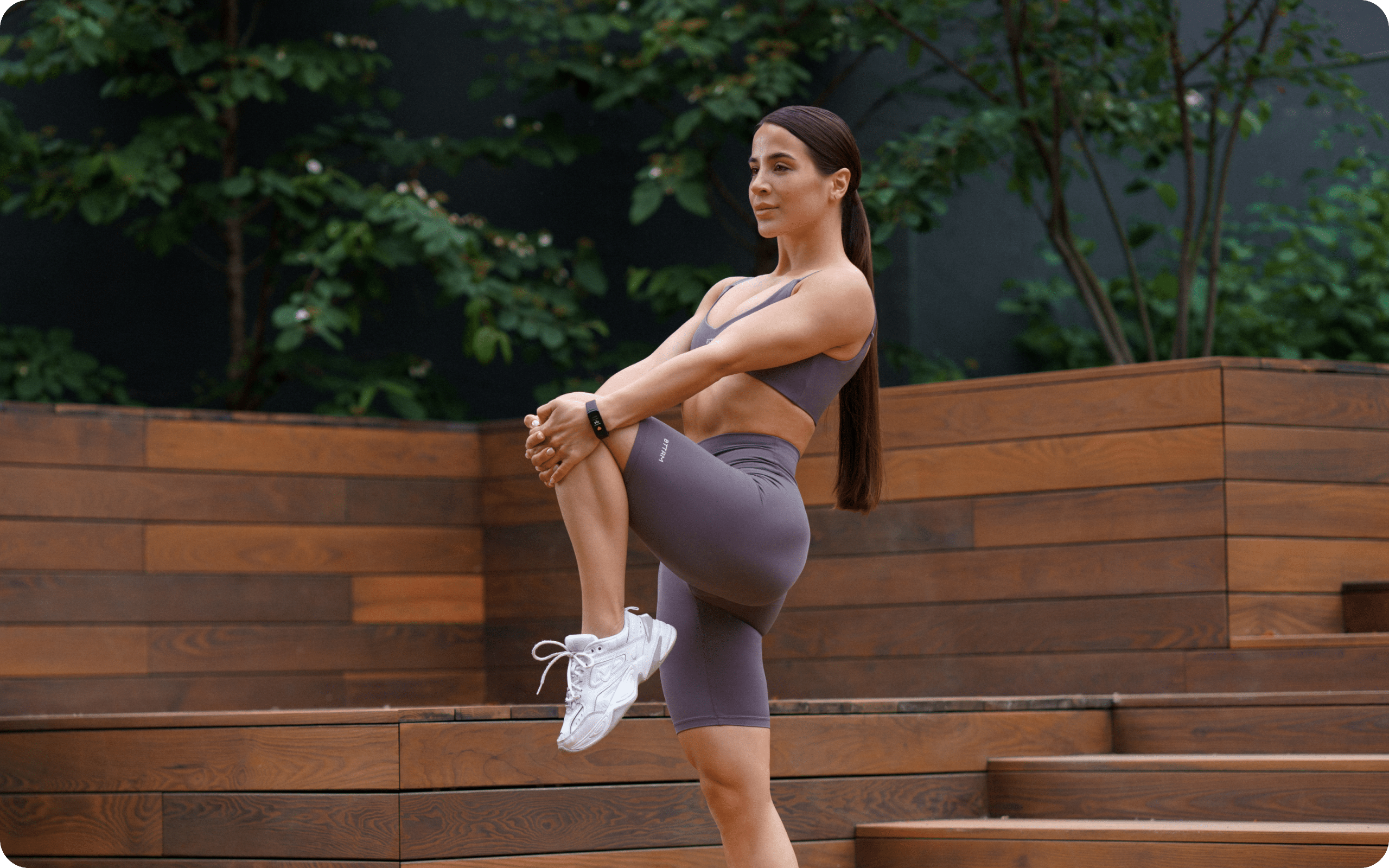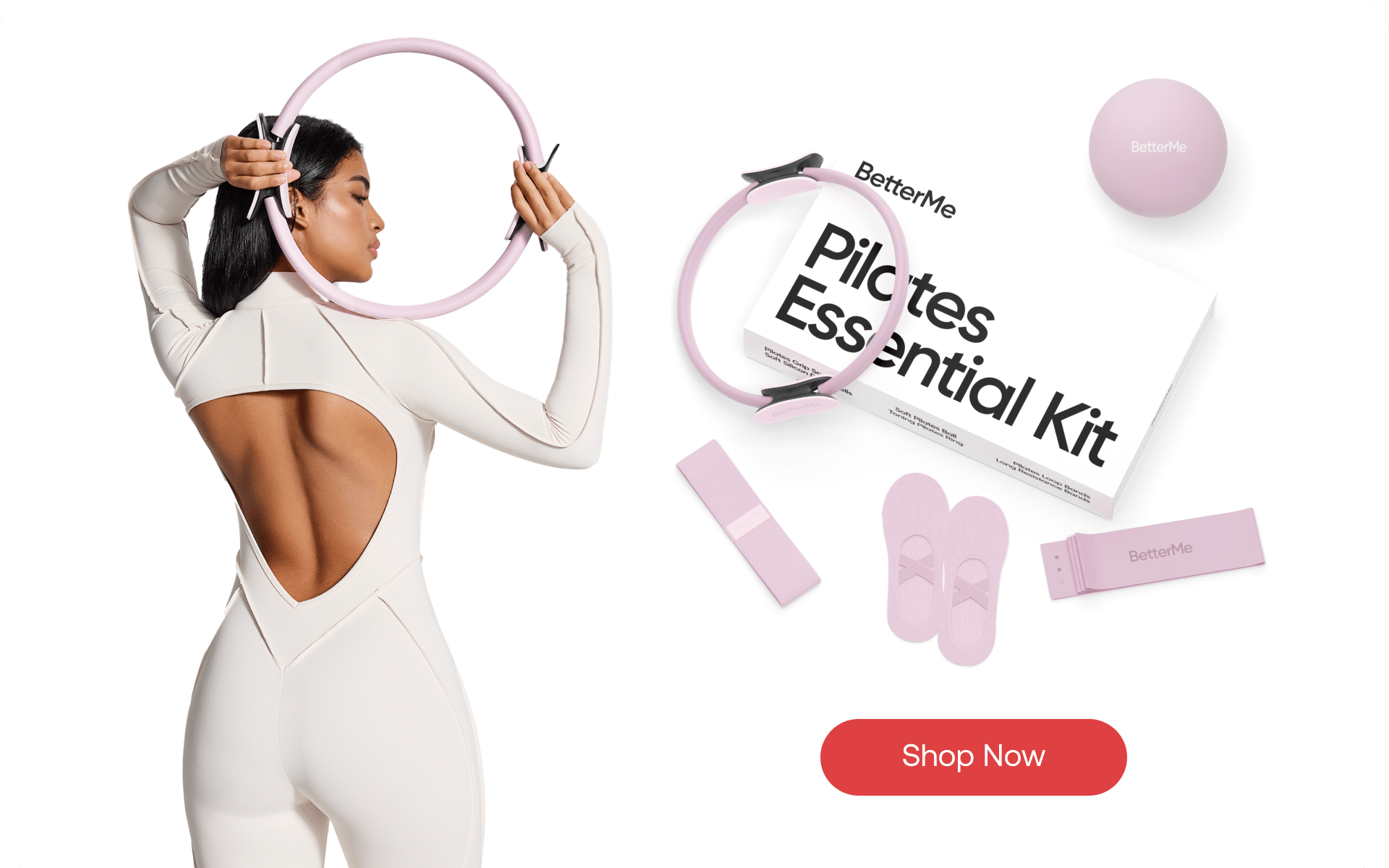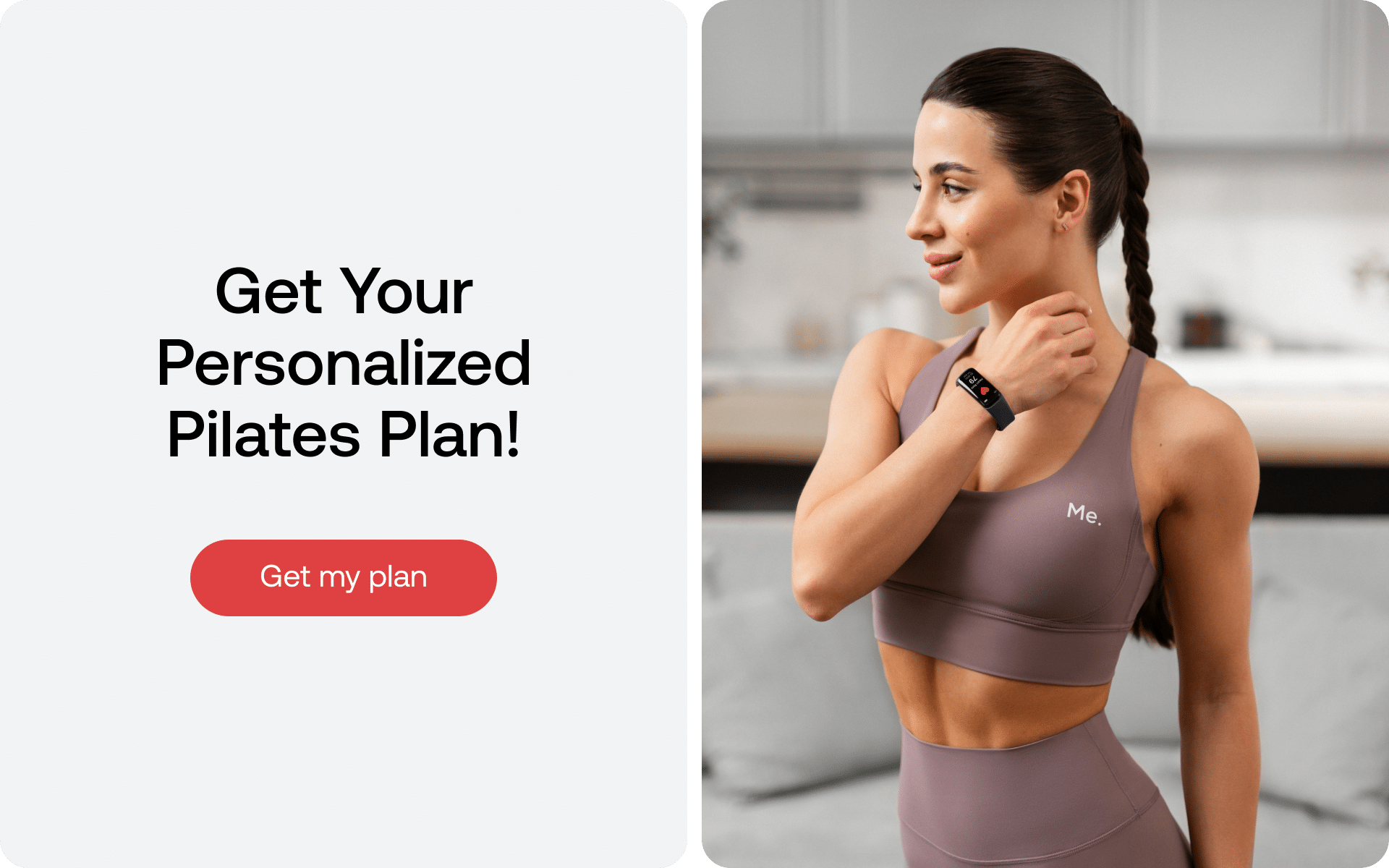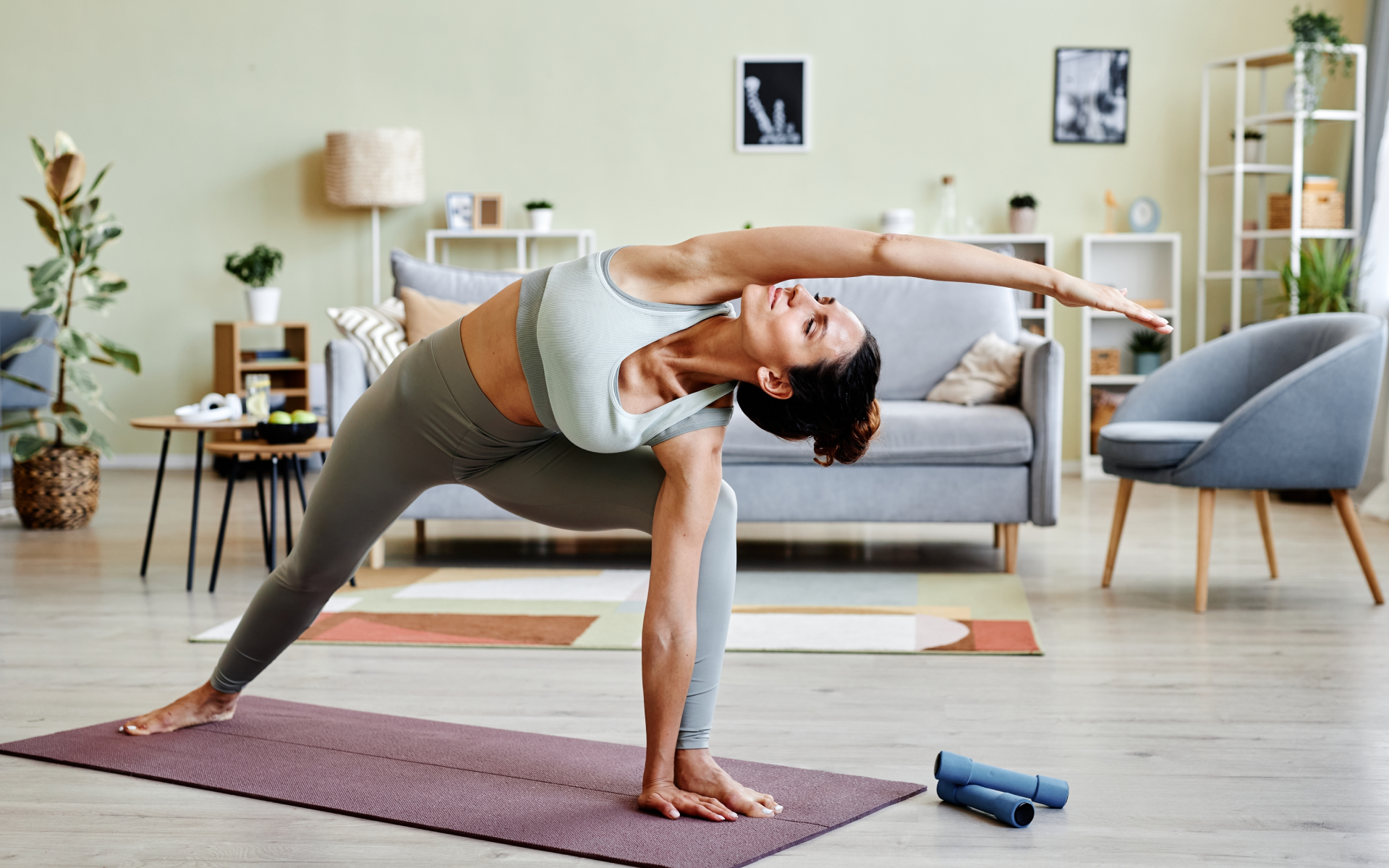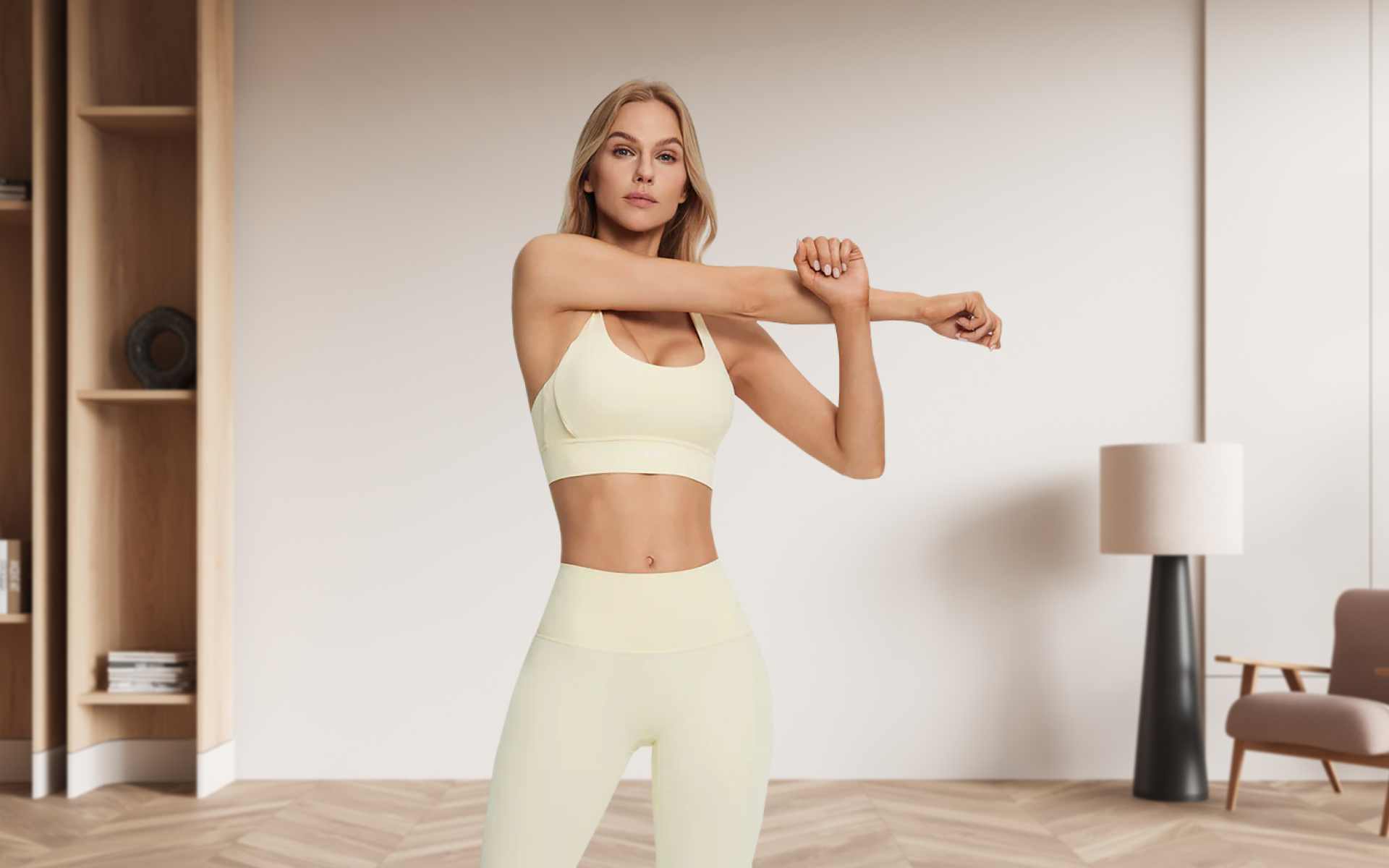Expert recommendations suggest that adults should get at least 150 minutes of moderate-intensity exercise per week (1). This breaks down to about 30 minutes a day, five days a week.
According to the American Heart Association, this level of physical activity can help reduce the risk of chronic diseases such as heart disease, stroke, type 2 diabetes, and certain types of cancer (2).
But what if you only have 10 minutes to spare in your busy schedule? Is this enough to have an impact on your physical fitness?
The short answer is yes – 10 minutes of Pilates a day can definitely be beneficial for your body and mind. In fact, many fitness professionals believe consistency is key when it comes to maintaining a healthy lifestyle.
Committing to just 10 minutes of Pilates each day may be more sustainable and realistic for some individuals than longer workout sessions.
Will Working Out 10 Minutes a Day Make a Difference?
Working out for just 10 minutes a day can indeed make a difference, especially if you’re consistent and focused on the right types of exercises.
Short, intense workouts can improve your cardiovascular health, boost your mood, and increase your energy levels. They can also help with weight management and muscle toning when combined with a healthy diet (3). Intensity aside, any amount of physical activity is better than none at all.
While 10 minutes may not be enough for significant muscle building or endurance training, it’s a great start for beginners or those with busy schedules. Consistency is key, and even small amounts of daily exercise can contribute to overall health improvements.
Is 10 Minutes a Day of Pilates Enough?
Committing just 10 minutes a day to Pilates can yield some benefits. Here’s how a short, daily practice can enhance various aspects of your fitness and well-being.
- Enhanced Core Strength
One of the most celebrated benefits of Pilates is its ability to improve core strength. The core isn’t just your abs, it encompasses your entire trunk, including the obliques, lower back, and pelvic floor.
A consistent 10-minute Pilates routine provides focused exercises that engage these muscles, leading to a stronger and more stable core. Over time, this strength supports better movement efficiency and protects the spine, which reduces the risk of back pain (4).
BetterMe will shake off your mental funk, rid you of your energy-zapping habits, and help you sculpt the body of your dreams. Intrigued? Hurry up and change your life for the better!
- Improved Flexibility
Flexibility is essential for maintaining a healthy range of motion and preventing injuries. Pilates incorporates a variety of stretches and movements that gently increase flexibility in muscles and joints (5).
A daily 10-minute session can gradually lengthen tight muscles, enhance joint mobility, and improve overall flexibility. As your flexibility increases, you’ll notice better performance in other physical activities and daily movements becoming easier.
- Better Posture
Good posture is fundamental to overall health and affects everything from breathing to digestion. Pilates emphasizes alignment, awareness, and control, which are key components in achieving and maintaining proper posture (5).
A short daily practice helps correct imbalances and build strength in the postural muscles. As a result, you’ll stand taller and move with more grace and confidence, reducing the physical strain caused by prolonged rounded postures.
- Boosted Mental Well-Being
In addition to the physical benefits, Pilates offers profound mental health advantages. The practice encourages mindfulness, focus, and deep breathing, which are all effective stress reducers (6).
A 10-minute routine can serve as a mini-meditation session, helping clear your mind and boost mental clarity.
Over time, the mental discipline cultivated by Pilates can enhance concentration, reduce anxiety, and promote a sense of calm and well-being.
Read more: List of Somatic Exercises for Mental and Physical Well-Being
- Effective Injury Prevention
Pilates is known for the role it plays in injury prevention. By strengthening the core, improving flexibility, and promoting balance, it helps to safeguard the body against common injuries (7).
A daily routine conditions the muscles to respond better to physical demands, which reduces the likelihood of strains and sprains. In addition, the focus on control and precision enhances body awareness, which makes you more attuned to your body’s limits and capabilities.
- Improved Circulation
A sedentary lifestyle can lead to poor circulation, increasing the risk of various health issues. Pilates incorporates movements that stimulate blood flow throughout the body (8).
Even a brief 10-minute session can enhance circulation, delivering more oxygen and nutrients to tissues and organs. Improved circulation helps reduce the risk of blood clots, varicose veins, and cardiovascular problems that are associated with prolonged sitting.
- Reduced Muscle Stiffness
Sitting for long periods often results in muscle stiffness and discomfort. Pilates focuses on deliberate, controlled movements that stretch and strengthen muscles, which can alleviate stiffness (9).
Daily practice helps to maintain muscle elasticity and joint mobility, which makes it easier to move without pain or restriction. Regularly engaging in Pilates can counteract the tightness that develops from a sedentary lifestyle.
- Enhanced Energy Levels
A sedentary lifestyle often leads to diminished energy levels and fatigue. Pilates boosts energy by promoting efficient breathing techniques and increasing circulation, which enhances oxygen flow throughout the body.
A quick 10-minute session can invigorate your system, providing a burst of energy and alertness that carries you through the day. This increased vitality can significantly improve your productivity and overall quality of life (9).
How Many Calories Do You Burn in 10 Minutes of Pilates?
In a 10-minute Pilates session, the calories burned can vary based on the intensity of the workout and the individual’s weight. On average, a beginner may burn approximately 4 calories per minute, which totals approximately 40 calories in 10 minutes. For intermediate and advanced levels, the burn rate increases to 6 and 7.5 calories per minute, respectively, resulting in 60 to 75 calories burned in 10 minutes (10). You should keep in mind that these numbers are estimates and can vary depending on an individual’s body composition and the effort exerted during the session.
What Is an Effective Way to Do 10 Minutes of Pilates a Day?
Here are some tips to make the most out of a 10-minute Pilates routine:
- Find a designated spot: Designate a specific area in your home where you can comfortably do your Pilates practice. Having a consistent location will help create a sense of routine and make it easier to stick to your daily session.
- Schedule it in: Treat your 10-minute Pilates practice as an important appointment with yourself. Set aside time in your schedule, whether this is before work, during your lunch break, or after dinner, and stick to it like any other commitment.
- Use online resources: There are numerous free online resources available that offer guided 10-minute Pilates routines. This makes it easier to follow along and ensure you’re doing the exercises correctly.
- Keep it simple: Don’t feel pressured to do an elaborate or intense workout in just 10 minutes. Focus on simple, foundational exercises that target the core muscles and promote good posture.
- Mix it up: Variety is the key to staying motivated and engaged in any form of exercise (11). Mix up your Pilates routine by trying different exercises or incorporating props such as resistance bands or small weights.
- Listen to your body: As with any exercise, listen to your body’s cues and modify the movements if necessary. If something feels uncomfortable or painful, stop and try a different variation or consult a professional for guidance.
Here’s a sample 10-minute Pilates routine to get you started:
The Hundred
- Target: Core strength and stability
- How to Perform: Lie on your back, lift your legs to a tabletop position, and curl your head and shoulders off the mat. Pump your arms up and down by your sides while breathing in for five counts and out for five counts. Repeat for 10 cycles.
Roll-Up
- Target: Abdominals and spinal flexibility
- How to Perform: Start by lying flat with your arms extended overhead. Inhale to lift your arms toward the ceiling and slowly roll up through your spine to reach toward your toes. Exhale as you return to the starting position, articulating one vertebra at a time.
Single Leg Circles
- Target: Core stabilization and hip flexibility
- How to Perform: Lie on your back, extend one leg toward the ceiling, and keep the other leg bent. Draw small circles with your extended leg, keeping your core engaged. Perform 5 circles in each direction before switching legs.
Swan Prep
- Target: Back extension and posture
- How to Perform: Lie on your stomach with your hands under your shoulders. Inhale to lift your head, chest, and hands off the mat, keeping your elbows bent. Exhale to lower back down. Focus on lengthening through your spine.
Plank
- Target: Full-body strength and core engagement
- How to Perform: Hold a plank position on your forearms or hands, ensuring your body forms a straight line from head to heels. Engage your core and hold for 30 seconds, gradually increasing the time as you become stronger.
Integrating Pilates into a Busy Schedule
- Morning Wake-Up: Perform your routine immediately after getting out of bed to kickstart your metabolism and boost energy levels.
- Lunch Break Recharge: Use this time to step away from your desk for a quick session to refresh your mind and body.
- Evening Relaxation: Wind down after a long day with calming exercises that alleviate stress and tension.
Can You Get in Shape with Just Pilates?
Pilates is a highly effective form of exercise that can significantly contribute to getting in shape, particularly in terms of improving core strength, flexibility, and posture. It focuses on controlled movements and breathing, which can enhance muscle definition and body awareness.
Practicing Pilates regularly can lead to improved balance, reduced back pain, and better alignment, all of which are essential components of overall fitness (9).
BetterMe will keep you laser-focused on your weight loss journey! Nutrient-packed meal plans, fat-blasting workouts, galvanizing challenges and much more. Try using the app and see for yourself!
However, while Pilates offers numerous benefits, it has some limitations when it comes to cardiovascular fitness and muscle building. Pilates is generally low-impact and doesn’t typically elevate the heart rate enough to significantly improve cardiovascular endurance. In addition, while it helps strengthen muscles, it may not provide the same level of muscle hypertrophy as resistance training with weights.
For a well-rounded fitness routine, it’s advisable to complement Pilates with other forms of exercise. Including aerobic activities such as running, cycling, or swimming can boost cardiovascular health.
Weight training or resistance exercises can enhance muscle strength and endurance. By integrating these into your fitness regimen together with Pilates, you can achieve a balanced approach that promotes overall physical health and conditioning.
How Many Minutes of Pilates Should I Perform a Day to See Results?
As a general guideline, engaging in Pilates for 20 to 30 minutes a day can be effective for many people. This duration allows ample time to work on core strength, flexibility, and posture, which are the key benefits of Pilates.
However, even shorter sessions, such as 10 minutes a day, can still yield positive results, particularly if you’re new to exercise or have a busy schedule. The key is to maintain a regular routine and focus on performing each movement with precision and control.
Ultimately, the time spent on Pilates should be aligned with your personal fitness level and goals. Beginners can start with shorter sessions and gradually increase the duration as they gain strength and endurance. For those with specific fitness objectives, incorporating Pilates into a broader exercise regimen can help accelerate the results and ensure a balanced approach to fitness.
Read more: Can You Lose Weight Doing Pilates Every Day?
Is It Better to Do Pilates in The Morning or at Night?
Deciding whether to do Pilates in the morning or at night is largely dependent on personal preferences and lifestyle. Each time of day offers distinct benefits:
Morning Pilates: Practicing Pilates in the morning can be invigorating, setting a positive tone for the day. Morning sessions often lead to increased energy levels and improved focus, helping you tackle daily tasks with a clear mind. Engaging in physical activity immediately after waking up can kickstart your metabolism and provide a sense of accomplishment early on.
Evening Pilates: On the other hand, doing Pilates at night can serve as a perfect way to wind down after a hectic day. Evening sessions can help relieve stress and tension accumulated throughout the day, promoting relaxation and better sleep. This time allows you to focus on deep breathing and mindful movement, which can reduce anxiety and prepare your body for rest.
Ultimately, the best time to practice Pilates is when it can fit consistently into your schedule. Whether in the morning or at night, regular practice is key to reaping the physical and mental benefits of Pilates. Consider your daily commitments, energy levels, and personal goals to determine when Pilates can be seamlessly integrated into your routine.
Exercising for 10 minutes a day can contribute to weight loss, especially if it’s combined with a healthy diet and overall active lifestyle. While 10 minutes may not burn a significant number of calories compared to longer workouts, it can boost metabolism, improve mood, and support weight management over time. Consistency is key, and incorporating high-intensity interval training (HIIT) or strength exercises during these short sessions can maximize the calorie-burning effects. The 30-30-30 rule for weight loss involves consuming 30 grams of protein within 30 minutes of waking up, followed by 30 minutes of low-intensity exercise. This approach is claimed to kickstart metabolism and promote muscle maintenance while potentially helping with weight loss. In terms of its effectiveness, the rule can be beneficial for some individuals, particularly those who struggle with morning hunger or need a structured routine to boost their metabolism. However, as with any diet or exercise plan, its success is largely dependent on individual factors such as overall diet, lifestyle, and consistency. It’s always a good idea to consult a healthcare professional before you start any new diet or exercise regimen to ensure it is aligned with your personal health needs and goals. High-intensity interval training (HIIT) is often considered to be one of the most effective exercises for getting in shape quickly. HIIT involves short bursts of intense activity followed by brief rest periods, which can significantly improve cardiovascular fitness, increase muscle strength, and boost metabolism in a relatively short amount of time (12). Its efficiency makes it a popular choice for those who are looking to achieve fitness goals rapidly. Practicing Pilates every day can lead to numerous benefits, including improved core strength, flexibility, posture, and balance. Regular Pilates practice can enhance muscle definition and endurance while also promoting better alignment and body awareness. It can also reduce stress and improve mental focus (9). However, ensuring variety and rest days is essential to prevent overuse injuries and maintain overall physical health.Frequently Asked Questions
Will I lose weight if I exercise for 10 minutes a day?
What is the 30-30-30 rule for weight loss?
What exercise gets you in shape the fastest?
What will happen if I do Pilates every day?
The Bottom Line
The power of a 10-minute daily Pilates practice cannot be underestimated. It offers numerous physical and mental benefits, from improved core strength and flexibility to enhanced posture and energy levels.
Incorporating this simple routine into your daily life can result in significant long-term changes to your overall health and well-being. Rather than doing no exercise at all, taking just 10 minutes to prioritize your physical and mental health can make a world of difference.
DISCLAIMER:
This article is intended for general informational purposes only and does not serve to address individual circumstances. It is not a substitute for professional advice or help and should not be relied on for making any kind of decision-making. Any action taken as a direct or indirect result of the information in this article is entirely at your own risk and is your sole responsibility.
BetterMe, its content staff, and its medical advisors accept no responsibility for inaccuracies, errors, misstatements, inconsistencies, or omissions and specifically disclaim any liability, loss or risk, personal, professional or otherwise, which may be incurred as a consequence, directly or indirectly, of the use and/or application of any content.
You should always seek the advice of your physician or other qualified health provider with any questions you may have regarding a medical condition or your specific situation. Never disregard professional medical advice or delay seeking it because of BetterMe content. If you suspect or think you may have a medical emergency, call your doctor.
SOURCES:
- Physical Activity Guidelines (n.d., acsm.org)
- American Heart Association Recommendations for Physical Activity in Adults and Kids (2024, heart.org)
- Research shows that short, intense workouts are beneficial (2023, ucla health.org)
- Pilates to Improve Core Muscle Activation in Chronic Low Back Pain: A Systematic Review (2023, mdpi.com)
- Pilates for improvement of muscle endurance, flexibility, balance, and posture (2010, nih.gov)
- The effects of pilates on mental health outcomes: A meta-analysis of controlled trials (2018, nih.gov)
- Pilates For Injury Prevention: Does It Really Work? (n.d., physio-central.com)
- The effect of pilates on body awareness, activity level, aerobic capacity, and balance in healthy young adults (2021, researchgate.net)
- Pilates – health benefits (2022, betterhealth.vic.gov.au)
- The effects of pilates exercise on lipid metabolism and inflammatory cytokines mRNA expression in female undergraduates (2014, nih.gov)
- Diversity in Training and Why It Matters: Five Good Reasons (n.d., strathconaphysicaltherapy.com)
- Evidence-Based Effects of High-Intensity Interval Training on Exercise Capacity and Health: A Review with Historical Perspective (2021, nih.gov)
